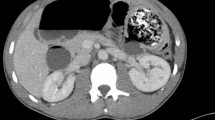Abstract
Introduction
Post-operative complications in surgery may frequently be unavoidable. However, some complications result from human error, both in the intra-operative and post-operative period. One such complication, which is frequently underreported, is the retained swab, or gossypiboma.
Case report
We report a case from our hospital of a patient who presented with unexplained pyrexia, 4 years post-gynaecological surgery in another institution. A 67-year-old woman from overseas presented to our emergency department with a 2-day-history of pyrexia, collapse and confusion. Following a CT guided biopsy, which was inconclusive, she was scheduled for retroperitoneal biopsy. In theatre, a retained swab was discovered.
Conclusion
Prevention of gossypiboma is far better than cure. Strict adherence to swab counts, and the avoidance of change of staff during procedures is important in decreasing the incidence. Perhaps, with the increasing use of minimally invasive procedures, the incidence of gossypiboma will fall dramatically.
Similar content being viewed by others
References
Yidirim S, Tarim A, Nursal TZ et al (2006) Retained surgical sponge (gossypiboma) after intraabdominal or retroperitoneal surgery: 14 cases treated at a single center. Langenbecks Arch Surg 391(4):390–395. doi:10.1007/s00423-005-0581-4
Gawande A, Studdert DM, Orav E, Brennan T, Zinner M (2003) Risk factors for retained instruments and sponges after surgery. N Engl J Med 348:229–235. doi:10.1056/NEJMsa021721
Bani-Hani K, Gharaibeh K, Yaghan R (2005) Retained surgical sponges. Asian J Surg 28:109–115
Apter S, Hertz M, Rubenstein ZJ (1990) Gossypiboma in the early post-operative period: a diagnostic problem. Clin Radiol 42:128–129. doi:10.1016/S0009-9260(05)82084-7
Lauwers PR, Hee RHV (2000) Intraperitoneal gossypiboma: the need to count sponges. World J Surg 24:521–527. 490
O’Connor AR, Coakley FV, Meng MV et al (2003) Imaging of retained surgical sponges in the abdomen and pelvis. AJR Am J Roentgenol 180(2):481
Gibbs VC, Coakley FD, Reines HD (2007) Preventable errors in the operating room. Curr Probl Surg 44(5):281. doi:10.1067/j.cpsurg.2007.03.002
Author information
Authors and Affiliations
Corresponding author
Rights and permissions
About this article
Cite this article
Kiernan, F., Joyce, M., Byrnes, C.K. et al. Gossypiboma: a case report and review of the literature. Ir J Med Sci 177, 389–391 (2008). https://doi.org/10.1007/s11845-008-0197-0
Received:
Accepted:
Published:
Issue Date:
DOI: https://doi.org/10.1007/s11845-008-0197-0




